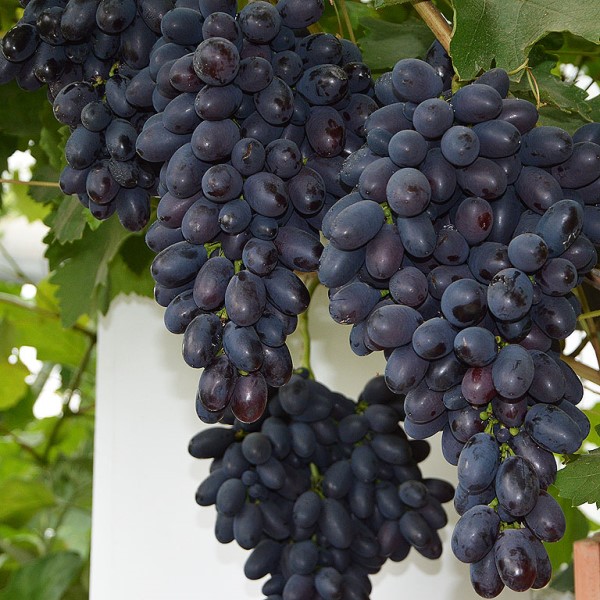Grapes have always been famous for their wonderful taste and benefit. There is a dark grape variety Kodryanka, which is in demand on the market for its taste and presentation. Many gardeners take up the cultivation of this variety, what should you know to get a decent crop? Further description of the variety.
Table of contents
Description of the grape variety Kodryanka
The variety was obtained by hybrid crossing more than 50 years ago in Moldova.Received widespread in the USSR and abroad, there he is known as "Black Magic". The Moldova and Marshall grape varieties are the genetic basis of the variety.
Hereditary traits that were acquired from parental forms:
- frost resistance average (-23 ° C)
- the stems of clusters are dense and durable, do not break off under the gravity of the fruit
- load on the main runaway average
- large fruit
- disease resistance
- early ripening (110 - 120 days, August, fructification until the end of September, beginning of October)
- bushes grow much
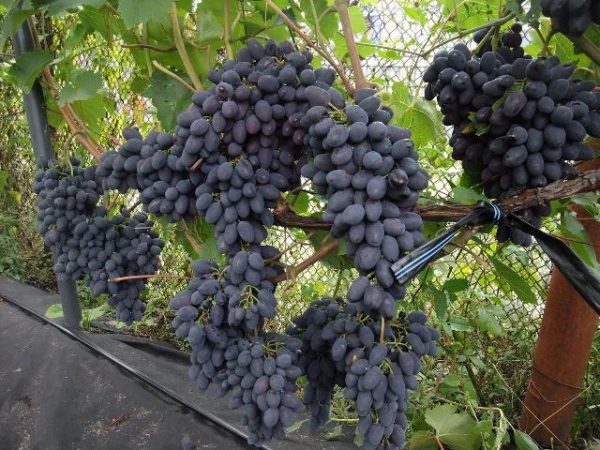
Individual characteristics of the variety:
- moderate density and arrangement of clusters on a bush
- 500 to 600 g weight of one bunch
- high yield (50 c / ha)
- second year fruit bearing
Grapes in one place you can grow up to 30 years, if you follow the composition of the soil and retain moisture and nutrients as much as possible.
The content of the main elements:
- Sugar content - 18 - 20%
- Acid content 6 - 7.5 g / l
- Water - 79.9%
- Proteins - 0.6 g / 100g
- Fat - 0.6 g / 100g
Characteristic berries
- 1 - 2 bones in one berry
- fruit weight 6 - 8 g
- berries do not fall off for a long time when ripe, last up to 25 days
- tendency to small-scale formation of fruits, peas, with unfavorable climate and care
- fruit height 3.2 cm, width 2 cm, elongated, ovate
- dark purple color
- firm flesh
- fine skin with medium wax coating
- taste is simple harmonious

Advantages and disadvantages
The advantages of the variety include, first of all:
- high yield
- it is well kept at the optimum temperature and air humidity
- Minimum damage during shipping
- maintains temperature - 23 ° С
- pleasant taste
- early ripening and long fruiting
- resistance to diseases of grapes mildew and gray rot
Minuses
- with inadequate care small fruits are formed, which reduces the demand in the market. But using gibberellins, this problem is solved.
- requires shelter in regions where the temperature decreases by more than - 24 ° C, which incurs material costs
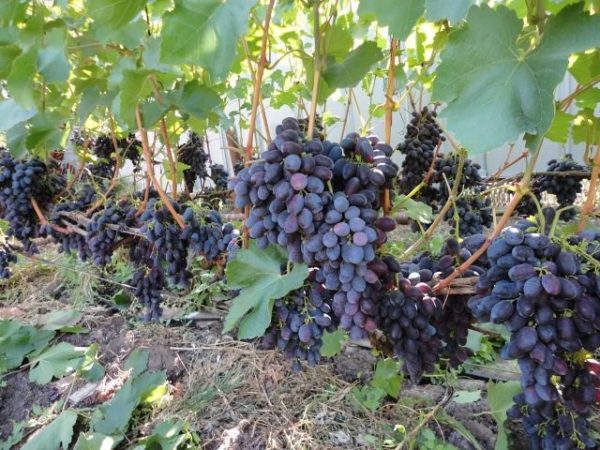
Planting culture
Grapes are mainly grown by cuttings.
When buying planting material, in particular one-year seedlings, you should pay attention to the appearance of the culture.
Sapling must meet the following requirements:
- the plant should not be visible diseases, tumors and any mechanical damage
- the root system should have a well-developed main root and many small, fibrous roots
- the main shoot should be smooth and strong, exceed the others in height and have a vertical direction
- the plant should be 2 - 3 healthy buds
Site selection
Basic requirements for the selection of the site:
- the plot is well lit
- relief without obvious drops, possible landing on a slope of 11 - 12 °
- the soil on the site should be not saline
- groundwater is lower than all plant roots
- minimum number of weeds
Planting seedlings
Planting grapes can be held in the spring, when the temperature of the soil will be 10 ° or in the fall before frost. Month and number depends on the region.
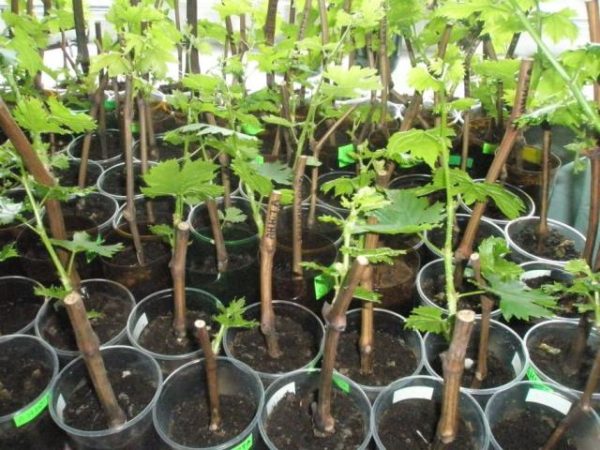
- Digging a hole the size of 80 by 80 cm, twice the depth of the root system. In the spring pits dig 14 days before disembarkation.
- Holes set aside for 2 - 3 hours, while watering 3 - 4 times
- With the help of gravel, broken brick, or rubble, a drainage layer of 4-6 cm is created.
- Further, the drainage is superimposed fertile soil, with the addition of organic and mineral fertilizers. Fertilizer application rate is indicated on packages.
- The culture is lowered into the pit, leveling the roots, and covered with soil, making a depression around it.
- Abundant watering.
- On top of the mulch layer - the remnants of weeds, straw.
Planting grapes
Let us examine two growing schemes:
Private landing method
Culture planted in a row of two plants in a checkerboard pattern. The aisle is 2.4 m, between the plants is 0.65 m. Or just one plant in a row, the aisle is 2.5 m, and between the saplings is 1.5 - 2 m. This is a way to grow in field conditions.
Shpaler landing method
In this case, the plant forms a green wall of the vineyard, the distance between the plants is 1.5 m. Suitable for growing at home.
Care for a young and mature vine
Regular watering is performed as rain falls. 5 liters per plant, depending on the weather. Should monitor the soil moisture. Mineral fertilizers: in the spring it is necessarily nitrogen, after 20 days nitrogen, phosphorus, potassium, after 30 days phosphorus potassium.
At the stage of the first year of life it is necessary to conduct formative pruning, to create the desired shape of the bush.
Caring for a mature vine is a little different. Watering, fertilizer as well. Trimming is different. Basically spend two types of trimming:
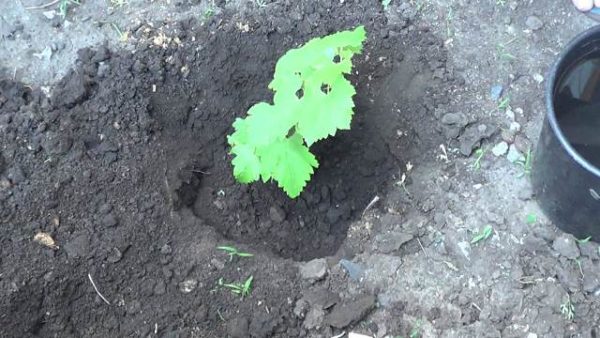
- Annual pruning, necessary to preserve the shape of the bush.
- The soothing cut. It is carried out to replace old shoots with young ones.
- Sanitary pruning. Removed sick, unviable shoots.
Breeding methods
Reproduction is done by layering and cuttings.In order to propagate the plant by cuttings, cut off the shoots with 2 - 3 buds, then rooted. For reproduction by cuttings from different parts of the plant, shoots are taken away, they lean against the soil by buds and fall asleep, the roots are formed. After the formation of the roots and stem, the place of cutting is trimmed.
Diseases and pests
Damaged by disease: rubella, bacterial cancer, chlorosis, anthracnose, bacteriosis. Against these diseases there are specialized chemical and biological substances.
Insects harm: spider mite, philoxer. With the help of proper annual tillage, the threshold for insect data is reduced.
At home, using folk remedies in the fight against insects and diseases.
Grapes are an exceptional variety that will always be popular for its irreplaceable qualities and taste. Every amateur gardener can afford to cultivate this crop.
